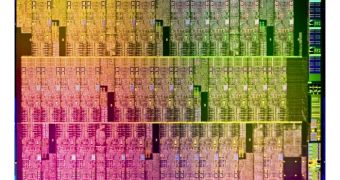Intel tried to take away NVIDIA's potential market share for PCI Express compute accelerators with the Xeon Phi cards, but it mostly failed, even though Phi did get some business. Now, it's going back to the origins.
Which is to say, the Santa Clara, California-based company is turning the Many Integrated Core Architecture (MIC) into a CPU again.
Knights Landing will be the first, and now we know its actual specifications: there will be up to 72 cores, up to 16GB of DRAM 3D stacked on-package (up to 500 GB/s memory bandwidth) and support for a maximum 384 GB DDR4-2400 motherboard memory.
Basically, the processor will be almost a PC on a chip with scalable mainboard resource support.
It's kind of a relief that it won't be out before 2015. As it is, it's enough to blow people's minds.
For comparison, Xeon Phi cards have up to 61 cores (Pentium, not Silvermont Atom like on Knights Landing) and 512-bit vector registers (Knights Landing will have AVX-512 / AVX 3.1 instructions).
In layman terms, Intel will provide supercomputer makers (like Cray) with a very mighty CPU, enough to allow 3 TFLOP double precision performance per socket.
Thus, there will be supercomputers with total performance of 100 petaflops or more, and eventually exascale ones.
Meanwhile, the use of 14nm manufacturing technology will ensure energy efficiency beyond what is possible today.
So, all this being said, we can expect a lot of outstanding additions to the Green 500 list (lists supercomputers in order of energy savings), not just the Top 500 (lists them in order of raw performance).
Finally, Intel Knights Landing processors will possess, in addition to the six-channel DDR4-2400 support and up to 16 GB on-die stacked RAM, 36 PCIe 3.0 lanes. So we can safely assume that a bunch of NVIDIA Tesla K40 cards will make it into the same system modules as them.

 14 DAY TRIAL //
14 DAY TRIAL //